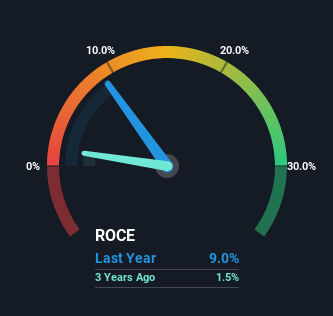Pearl River Holdings (CVE:PRH) Is Experiencing Growth In Returns On Capital
What are the early trends we should look for to identify a stock that could multiply in value over the long term? One common approach is to try and find a company with returns on capital employed (ROCE) that are increasing, in conjunction with a growing amount of capital employed. If you see this, it typically means it's a company with a great business model and plenty of profitable reinvestment opportunities. With that in mind, we've noticed some promising trends at Pearl River Holdings (CVE:PRH) so let's look a bit deeper.
What Is Return On Capital Employed (ROCE)?
Just to clarify if you're unsure, ROCE is a metric for evaluating how much pre-tax income (in percentage terms) a company earns on the capital invested in its business. Analysts use this formula to calculate it for Pearl River Holdings:
Return on Capital Employed = Earnings Before Interest and Tax (EBIT) ÷ (Total Assets - Current Liabilities)
0.09 = CN¥15m ÷ (CN¥220m - CN¥55m) (Based on the trailing twelve months to September 2022).
So, Pearl River Holdings has an ROCE of 9.0%. In absolute terms, that's a low return and it also under-performs the Chemicals industry average of 13%.
View our latest analysis for Pearl River Holdings

While the past is not representative of the future, it can be helpful to know how a company has performed historically, which is why we have this chart above. If you'd like to look at how Pearl River Holdings has performed in the past in other metrics, you can view this free graph of past earnings, revenue and cash flow.
What Can We Tell From Pearl River Holdings' ROCE Trend?
Even though ROCE is still low in absolute terms, it's good to see it's heading in the right direction. The numbers show that in the last five years, the returns generated on capital employed have grown considerably to 9.0%. The company is effectively making more money per dollar of capital used, and it's worth noting that the amount of capital has increased too, by 65%. The increasing returns on a growing amount of capital is common amongst multi-baggers and that's why we're impressed.
In Conclusion...
All in all, it's terrific to see that Pearl River Holdings is reaping the rewards from prior investments and is growing its capital base. Astute investors may have an opportunity here because the stock has declined 27% in the last five years. So researching this company further and determining whether or not these trends will continue seems justified.
If you want to know some of the risks facing Pearl River Holdings we've found 3 warning signs (2 are a bit concerning!) that you should be aware of before investing here.
While Pearl River Holdings may not currently earn the highest returns, we've compiled a list of companies that currently earn more than 25% return on equity. Check out this free list here.
New: Manage All Your Stock Portfolios in One Place
We've created the ultimate portfolio companion for stock investors, and it's free.
• Connect an unlimited number of Portfolios and see your total in one currency
• Be alerted to new Warning Signs or Risks via email or mobile
• Track the Fair Value of your stocks
Have feedback on this article? Concerned about the content? Get in touch with us directly. Alternatively, email editorial-team (at) simplywallst.com.
This article by Simply Wall St is general in nature. We provide commentary based on historical data and analyst forecasts only using an unbiased methodology and our articles are not intended to be financial advice. It does not constitute a recommendation to buy or sell any stock, and does not take account of your objectives, or your financial situation. We aim to bring you long-term focused analysis driven by fundamental data. Note that our analysis may not factor in the latest price-sensitive company announcements or qualitative material. Simply Wall St has no position in any stocks mentioned.
About TSXV:PRH
Pearl River Holdings
Through its subsidiaries, engages in the manufacture and distribution of plastic products in the People’s Republic of China, Australia, the United States, and internationally.
Moderate with mediocre balance sheet.
Market Insights
Community Narratives



